Greece is an open museum. No matter which part of the country you visit, Ancient Greece is there to greet you. This can be seen when visiting Chaeronea (Greek: Χαιρώνεια), a once-important village in the regional unit of Boeotia, only a couple of hours outside Athens.Today, the capital of Boeotia is Levadeia and its largest city is Thebes.
Chaeronea was first referred to by Homer, the author of the two epic poems, the Iliad and the Odyssey, with the name Arne (Greek: Άρνη), after the daughter of Aeolus, ruler of the winds. It was renamed Chaeronea in 1916, after the local hero Chaeron, one of the sons of the Olympian Sun God Apollo.
The importance of Chaeronea is due to the battle that was fought there in 338 BC between Macedonia under Phillip II and an alliance of Greek city-states led by Athens and Thebes. The battle, described as one of the most decisive of the ancient world in the way it was carried out, was the culmination of Phillip’s final campaigns in 339-338 BC, resulting in a victory for the Macedonians and their allies.
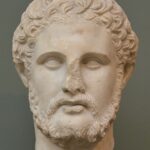 Phillip took control of the right wing of the Macedonian army and placed his 18-year-old son Alexander (the future conqueror of the Persian Empire) in command of the left wing, accompanied by a group of Phillip’s experienced generals. After a long fight, the Macedonians crushed both flanks of the allied army and caused them to flee.
Phillip took control of the right wing of the Macedonian army and placed his 18-year-old son Alexander (the future conqueror of the Persian Empire) in command of the left wing, accompanied by a group of Phillip’s experienced generals. After a long fight, the Macedonians crushed both flanks of the allied army and caused them to flee.
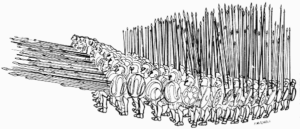
Phillip’s strategy of using Epaminondas’ deeper phalanx and Iphicrates’ combination of a longer spear and a smaller and lighter shield was the secret behind his victory. Epaminondas was a Theban general and politician and Iphicrates was an Athenian general, both 4th c. BC. Phillip had also introduced the use of a much longer spear, the two-handed pike called ‘sarissa’. The use of the longer spears by the Macedonian phalanx improved its strength as it extended the rows of overlapping weapons projecting towards the enemy.
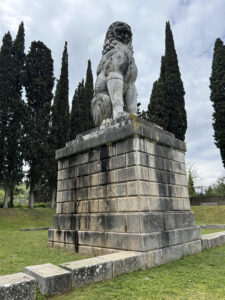
At the entrance of the village is the impressive Lion of Chaeronea, a 3.8m high sculpture on a marble pedestal about 3 m high. It was erected by the Thebans to honour the Sacred Band of Thebes (Greek: Ιερός Λόχος), a 300-strong elite force of the Theban army in the 4th century BC. The statue was erected above the mass grave of these brave soldiers. Near the monument is the tumulus (mound) of the polyandrion, the communal tomb where the Macedonia warriors are buried.
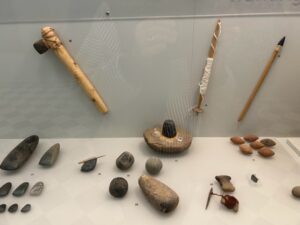
Close by is the Archaeological Museum of Chaeronea, which is organized in three parts with exhibits ranging in date from the Prehistoric Age to the Early Chistian period. Besides the display of weapons, vases and small objects from the tumulus (mound) of the Macedonians who fell in battle, there are a few noteworthy sculptures including a kouros, a part of a funerary stele from Chaeronea, and a sphere with the relief busts of Helios (Sun) on one side and Selene (Moon) on the other.
In the centre of the room is the statue of Cybele (Greek: Κυβέλη) from the nearby township of Levadeia, the work of the Athenian sculpture Hermeias.
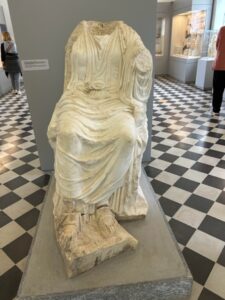 Cybele is an Anatolian mother goddess from Phrygia (Greek: Φρυγία), a kingdom in the central west of Anatolia, centered on the Sangarios River, in today’s Turkey. Greek colonists in Asia Minor adopted and adapted her cult and spread it to mainland Greece and to the western Greek colonies around 6th century BC, assimilating certain aspects with the Earth-goddess Gaia of Greek mythology. Gaia, meaning ‘land’ or ‘earth’ is the personification of Earth. She is the ancestral mother of all life.
Cybele is an Anatolian mother goddess from Phrygia (Greek: Φρυγία), a kingdom in the central west of Anatolia, centered on the Sangarios River, in today’s Turkey. Greek colonists in Asia Minor adopted and adapted her cult and spread it to mainland Greece and to the western Greek colonies around 6th century BC, assimilating certain aspects with the Earth-goddess Gaia of Greek mythology. Gaia, meaning ‘land’ or ‘earth’ is the personification of Earth. She is the ancestral mother of all life.
Other sites of interest are an outdoor theatre, the Tholos Tomb “Treasure of Minyas”, the Roman baths, the Panagia Skripou Monastery located in the village of Orchomenus as well as the Monastery of Lykourisi, also known as Panagia tou Myrou located within the gorge of the small river Aimonas, which served as the base of operations for Greek revolutionary Athanasios Diakos in the liberation of Levadeia in 1821 from the Ottomans.